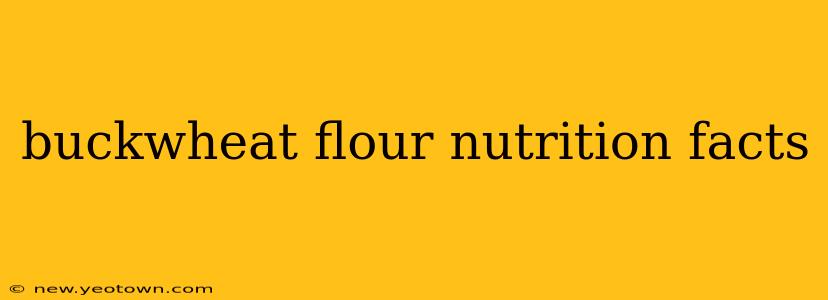Buckwheat. The name itself conjures images of rustic pancakes and hearty, wholesome meals. But beyond its culinary applications lies a nutritional powerhouse packed with benefits often overlooked. Let's unravel the nutritional tapestry of buckwheat flour, exploring its components and understanding why it's earned a place in health-conscious kitchens worldwide.
My journey into the world of buckwheat flour began with a simple question: Is it truly as nutritious as people claim? What started as a personal quest quickly evolved into a fascination with this ancient grain's unique properties. I dove into research papers, nutritional databases, and even experimented in my own kitchen, all to bring you a comprehensive understanding of this remarkable flour.
What is Buckwheat Flour?
Before we delve into the nutritional details, let's clarify a common misconception: buckwheat is not related to wheat. It's actually a seed from a plant in the same family as rhubarb and sorrel. This distinction is crucial because it means buckwheat flour is naturally gluten-free, a significant advantage for individuals with celiac disease or gluten sensitivity.
Buckwheat Flour Nutritional Content: A Detailed Breakdown
Buckwheat flour boasts an impressive nutritional profile. A typical serving (100g) provides a substantial dose of:
- Fiber: A significant source of both soluble and insoluble fiber, crucial for digestive health and regularity. This fiber also contributes to feelings of fullness, aiding in weight management.
- Protein: A good source of plant-based protein, containing all eight essential amino acids. This makes it a valuable addition to vegetarian and vegan diets.
- Magnesium: Essential for numerous bodily functions, including muscle and nerve function, blood sugar control, and blood pressure regulation.
- Manganese: Plays a vital role in bone health, wound healing, and metabolism.
- Copper: Important for iron absorption and the formation of red blood cells.
- Vitamin B6 (Pyridoxine): Contributes to brain development and function, and is essential for the metabolism of proteins and carbohydrates.
Compared to other flours, buckwheat flour often stands out due to its high fiber and protein content, making it a more filling and nutrient-dense option.
Is Buckwheat Flour Good for You? Exploring its Health Benefits
The nutritional richness of buckwheat flour translates into a range of potential health benefits:
- Improved Digestion: The high fiber content promotes healthy bowel movements and can alleviate constipation.
- Blood Sugar Control: Buckwheat's fiber and magnesium content can help regulate blood sugar levels, making it a beneficial addition to diets for managing type 2 diabetes.
- Heart Health: The presence of magnesium and fiber contributes to maintaining healthy blood pressure and cholesterol levels, promoting cardiovascular health.
- Weight Management: The high fiber content promotes satiety, potentially aiding in weight loss or maintenance efforts.
What are the Differences Between Buckwheat Flour and Wheat Flour?
This is a key question many people ask. Here's a quick comparison:
| Feature | Buckwheat Flour | Wheat Flour |
|---|---|---|
| Gluten | Gluten-free | Contains gluten |
| Fiber | High | Moderate to Low |
| Protein | High | Moderate |
| Glycemic Index | Low | Moderate to High |
Is Buckwheat Flour Keto-Friendly?
The answer is nuanced. While buckwheat flour is low on the glycemic index compared to wheat flour, it still contains carbohydrates. It's important to monitor your carbohydrate intake to ensure it aligns with your ketogenic diet goals. Use it sparingly and in moderation if following a strict keto diet.
Is Buckwheat Flour Paleo-Friendly?
The Paleo diet generally excludes grains. Therefore, buckwheat flour wouldn't typically be considered Paleo-friendly due to it being a seed rather than a leafy green or root vegetable often found on Paleo diets.
How Can I Incorporate Buckwheat Flour into My Diet?
Buckwheat flour’s versatility is one of its greatest assets. You can use it to make:
- Pancakes and Waffles: A delicious and nutritious alternative to traditional wheat-based versions.
- Bread: Add a unique flavor and texture to homemade bread recipes.
- Noodles: Perfect for creating gluten-free pasta.
- Cookies and other baked goods: Experiment with substituting a portion of your usual flour for buckwheat flour for added nutritional benefits.
My personal recommendation? Start with small substitutions in your favorite recipes. See how you like the taste and texture before committing to a full switch. The culinary world awaits your exploration of buckwheat flour!

